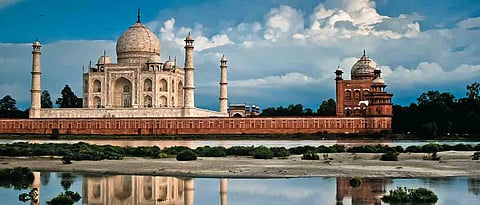
- Destinations
- Experiences
- Stay
- What's new
- Celebrating People
- Responsible Tourism
- CampaignsCampaigns
- SubscribeSubscribe
- Buy Now

In a recent discovery, the Archaeological Survey of India (ASI) has confirmed water seepage in the main dome of the Taj Mahal, following persistent rainfall in Agra. While the ASI reports no structural damage, the discovery at this UNESCO World Heritage Site has raised questions about conservation efforts and the impact on Agra’s hospitality and tourism industries. The seepage in one of the world’s most important monuments comes in as a concern equally for the tourist industry, conservation practices and history keepers.
Inside the central chamber of the Taj Mahal, ASI experts have found small patches of dampness on the marble ceiling. Recent intense monsoon showers and deteriorating seams in the outside marble panels of the dome seem to be the cause of the leak. According to ASI Director General V. Vidyavathi, monitoring systems are in place, and before the next rainy season begins in July, remedial pointing and grouting will be done. Officials underlined that there are no apparent fissures or urgent dangers, and the building's integrity is still intact.
Serious long-term risks to marble structures include water intrusion, which can cause interior discolouration, mould growth and discolouration as a result. In response, the ASI aims to carry out focused repairs and step up seepage monitoring during future rainstorms. Preventive maintenance is crucial because of the dome's aesthetic and symbolic significance to the Taj Mahal, according to conservation specialists.
Around eight million tourists visit the Taj Mahal annually, supporting Agra's hospitality industry. With international travel advisories and visitor numbers sensitive to heritage-site news, even small issues can have an impact on tourists' impressions. Uncertainty may cause reservations at hotels, restaurants, and tour companies to be hesitant, particularly during the monsoon season. Early ASI guarantees that the monument is secure, however, should reduce any negative effects.
Local hotel groups have expressed confidence in the Taj's ongoing appeal and praised the ASI's openness and prompt action. Officials from the Agra Tourism Board say they will use conservation teams' updates to reassure tourists, emphasising regular upkeep as evidence of a heritage monument that has been protected. The necessity for Agra's hospitality industry to continue having adaptable cancellation rules and aggressive communication tactics throughout the monsoon season is highlighted by the rain-related issue.
To stop frequent seepage, the ASI will improve drainage channels and install marble-joint grouting in the near future. Where needed, damp surfaces inside will be dried and disinfected. Rainfall-triggered evaluations will henceforth be part of scheduled inspections, and the results will be made public to preserve public trust. Unless there is additional damage, there are no expected visitor limitations.
Check Visitor Updates: Keep informed via official ASI and tourism channels before booking.
Monsoon-Friendly Planning: Agra’s hospitality providers offer indoor cultural experiences and advance Iftar-era visits—ideal during rain spells.
Look for Assurances: Choose hotels and tours that emphasise alignment with heritage-conservation timelines and guidelines.
The Taj's leak brings to light more general conservation issues that monuments in areas that are prone to monsoons face. New maintenance procedures are required due to climate change and aged infrastructure. Preserving the Taj is not only essential for Agra's cultural legacy; it also protects a whole economic system that depends on foreign visitors and hospitality.
